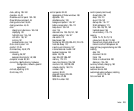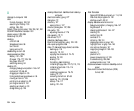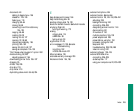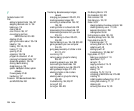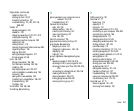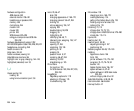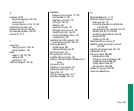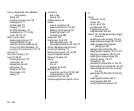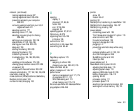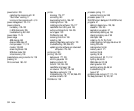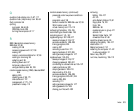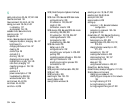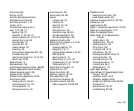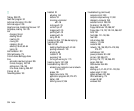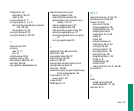
Q
question mark startup icon 5, 87, 117
question mark (Help menu) icon 83–84
Quit command 64
quitting
a program 56, 64, 65
SCSI disk mode 235
turning the computer off 17
R
RAM. See random-access memory
RAM disk 97–98
creating 97–98
conserving power with 97, 108
erasing 98
memory recommendations for 97, 99
resizing or removing 98
restarting and 99
shutting down and 97
temporary nature of 97
using as a startup disk 99, 108
random-access memory (RAM). See also RAM
disk
adding 245
checking use of 95, 171
disk cache and 172
management of 171–174
preserved in sleep 110
random-access memory (continued)
preserved under low-power conditions
103
programs’ use of 95
amount needed for RAM disk use 97, 99
32-bit memory and 174
virtual memory and 173–174
recharging the battery 103–106
reconnecting to shared disks 199
recording sound 141–142
registered group 207–208, 217
access privileges of 216, 217
exclusive access for 208–209
linking programs 224
naming 207
removing a user from 211
seeing members of 207–208
setting access privileges for 217
registered user 195, 216
access privileges of 216, 217
changing password 200–201
connecting to a shared disk as 195–197
creating a folder as 200
denying access to 209–210
disconnecting 213–214
exclusive access for 208–209
linking programs 220–221, 224
naming 205–206
removing 211
setting access privileges for 217
setting password for 206
sharing your files with 202
removing
battery 106–107
dirt 25
extra System Folders 79, 91
floppy disk 76, 120
fonts 186
RAM disk 98
registered user or group 211
sounds 141
System Folder items 157
unwanted files 67–68
repetitive stress injuries 26
replacing the battery 106–107
reset button 21
Restart command 7, 21
restarting the computer 21–22
to solve a problem 21
Return key 258, 277
run time, maximizing 108–112
Index 303



